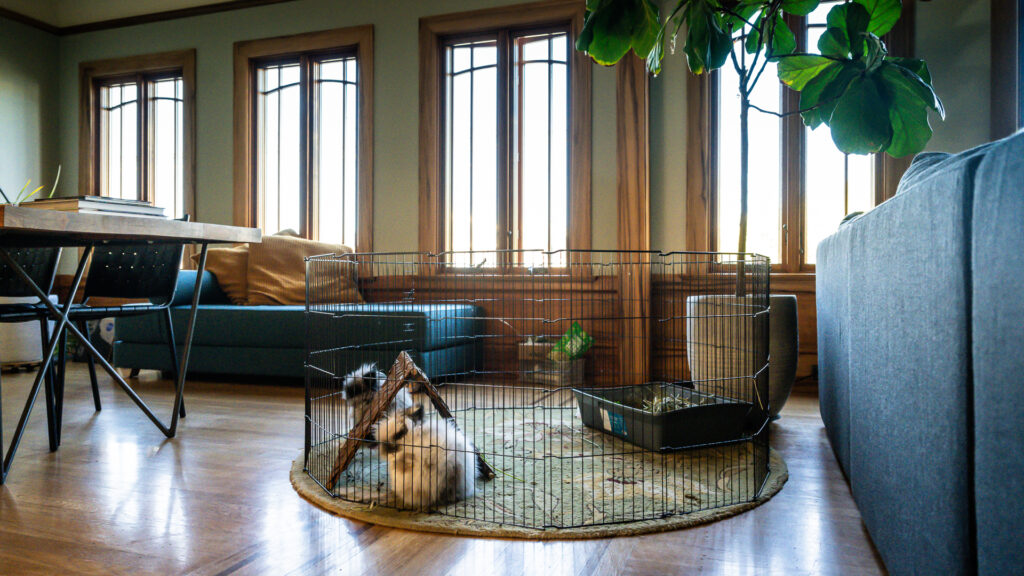A LARGE WELL-FURNISHED PEN can be the housing solution in itself. Although you can construct a pen from scratch, storebought pens are inexpensive, easy to use, and can be adapted to fit in nearly any home.
Wire shelving panels come in /0-inch squares that clip together in modules. I use these and like the flexibility of being able to reshape the living spaces, building them up or out, to fit the number and nature of the bunnies who live here. For instance, my older rabbits no longer need high fences, so a single panel is sufficient in height. I keep the upper decks covered with a rug or board to prevent feet from slipping through wide-mesh wire.
Metal-wire exercise pens (or x-pens), sold in pet supply stores, are by far the most popular rabbit housing of recent years. They can be expanded by adding sections and can be arranged in a variety of shapes. They are available in several heights.
Plastic lattice “play yards” ( for human toddlers) are available in department ⁄ variety stores. They can also be expanded by adding sections. Some rabbits chew the plastic; most do not.
All pens can be folded down, moved about, or stored. A pen is a good investment when you begin your life with bunnies. Panels clipped together can also be used as fencing to divide space creatively.
Floor Covering
Even bunnies with the best litterbox habits might spill hay and debris all over the floor. If the bunny area is on vinyl flooring, tile, or concrete, sweeping may not be a consideration. If it’s on carpeting, however, you might consider setting the pen on top of a patch of linoleum or a chair mat. Or you can lay down a small paint tarp or even a bed sheet, to catch debris.
In our own bunny room, we use the same durable floor surface as the HRS Rabbit Center habitats. FRP ( fiberglass-reinforced plastic) is glued onto plywood. The slightly bumpy surface gives bunnies a little traction but is highly cleanable, virtually chew proof, and available at most home-improvement stores.
Furnishings
Well-furnished rabbit areas contain a variety of fixtures and supplies. Some are strictly utilitarian, while others are intended to be used for comfort and recreational purposes.
Water bottle. Hanging water bottles with sipper tubes take up less space than crocks and make better use of small areas. Keep bottles out of direct sunlight (which encourages the growth of algae). Bottles should be checked daily, changed weekly, and washed with soap monthly. Check the sipper tubes daily for clogging.
Heavy clay crocks keep water fairly cool but occupy some floor space. Water in an open bowl is easily contaminated and should be changed daily.
Food dishes. Pellet bowls are made of clay, plastic, or stainless steel. Heavy clay crocks (smaller versions of water crocks) are less likely to be tipped over. If you want to use designer pottery, be sure that it is lead free. If you serve bunny salad on a platter, it’s best to use unbreakable plastic.
Hay hanger. If you’re not putting hay in a litterbox, a nicely stuffed basket can be used for bunny’s hay supply (caution on attached toys, page !”).
Washable rug. If your bunny runs on hard surfaces, give his feet a rest with padded areas. Soft fake-fleece rugs are ideal, as well as indoor⁄outdoor felt carpeting, cut to machine-washable sizes.
Towels/baby blankets. These are useful for padding a cage shelf, or rolled up as pillows around the edge of a pen, or as wicking material underneath a soiled rug. Any fabric with large holes or raveled, stringy edges should be removed.
Litterbox(es). Various sizes and shapes are available to fit your bunny’s space. They come in designer colors to fit your decor. Buy several. Some even have a lowered entrance for special needs.
Toys, large and small. As you will see in the next chapter, activities stimulated by toys are necessary for many reasons. All bunny spaces should be furnished with a wide selection of playthings.
©Copyright Marinell Harriman. All Rights Reserved. Republished with the permission of the author.
Pens: The modern housing preference was originally published in House Rabbit Handbook (5th ed.).

